Healthcare Service Marketing: Impact of Managerial Roles on Customers
VerifiedAdded on 2020/03/04
|8
|1784
|246
Essay
AI Summary
This essay delves into the realm of healthcare service marketing, focusing on the critical interplay between customer experience, managerial roles, and the overall wellbeing of patients. The analysis begins by emphasizing the significance of customer perceptions and feedback in shaping brand image and driving service improvements. It then explores the impact of managerial decisions and practices within Australian healthcare organizations, particularly how these influence the quality of customer service and patient satisfaction. The essay examines various aspects of the patient journey, from initial hospital visits to the complexities of receiving treatment, highlighting the importance of efficient processes, attentive staff, and effective communication. It also discusses the use of surveys, feedback mechanisms, and social media to enhance service quality and foster stronger customer relationships. The essay concludes by underscoring the importance of innovation, responsiveness, and a customer-centric approach to ensure the long-term success and sustainability of healthcare organizations.
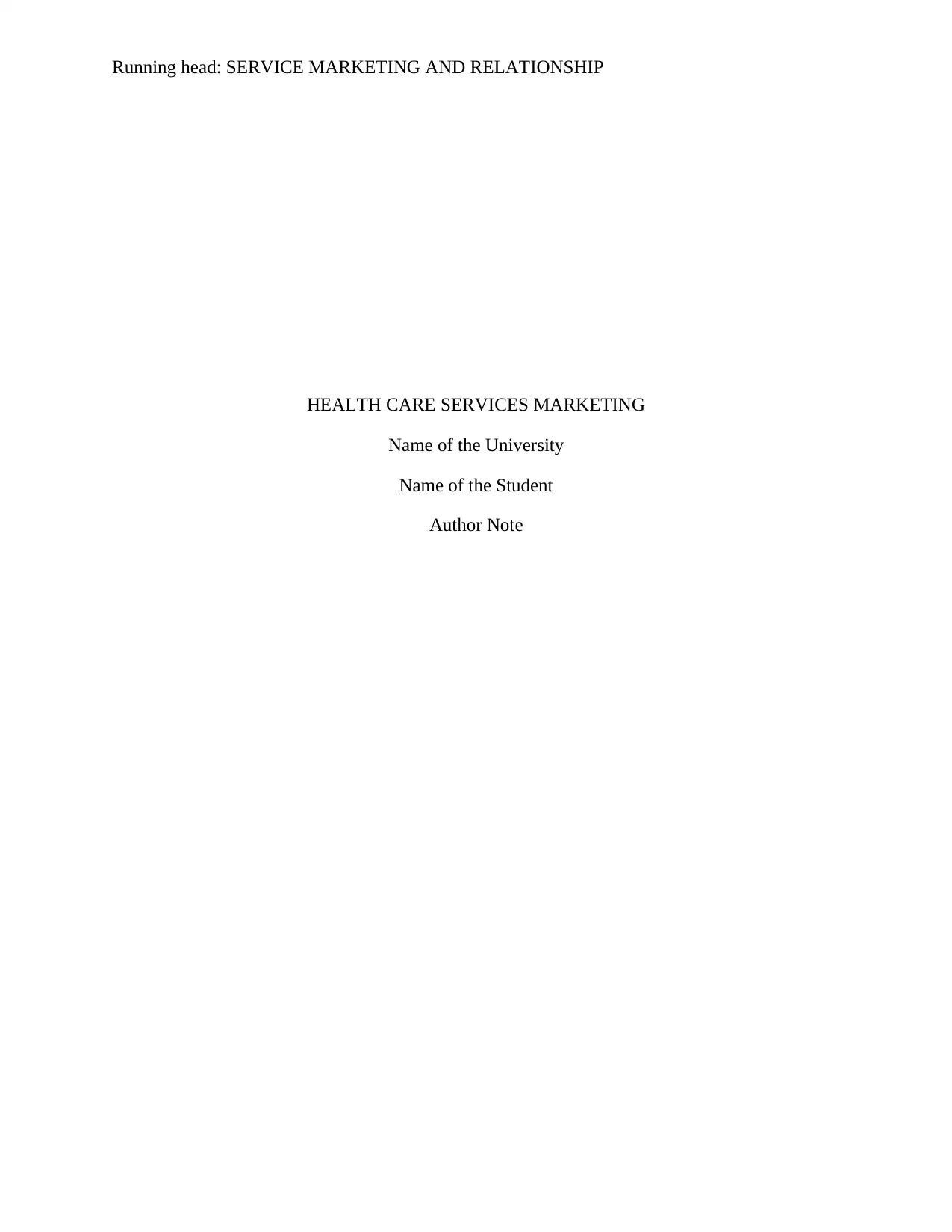
Running head: SERVICE MARKETING AND RELATIONSHIP
HEALTH CARE SERVICES MARKETING
Name of the University
Name of the Student
Author Note
HEALTH CARE SERVICES MARKETING
Name of the University
Name of the Student
Author Note
Paraphrase This Document
Need a fresh take? Get an instant paraphrase of this document with our AI Paraphraser
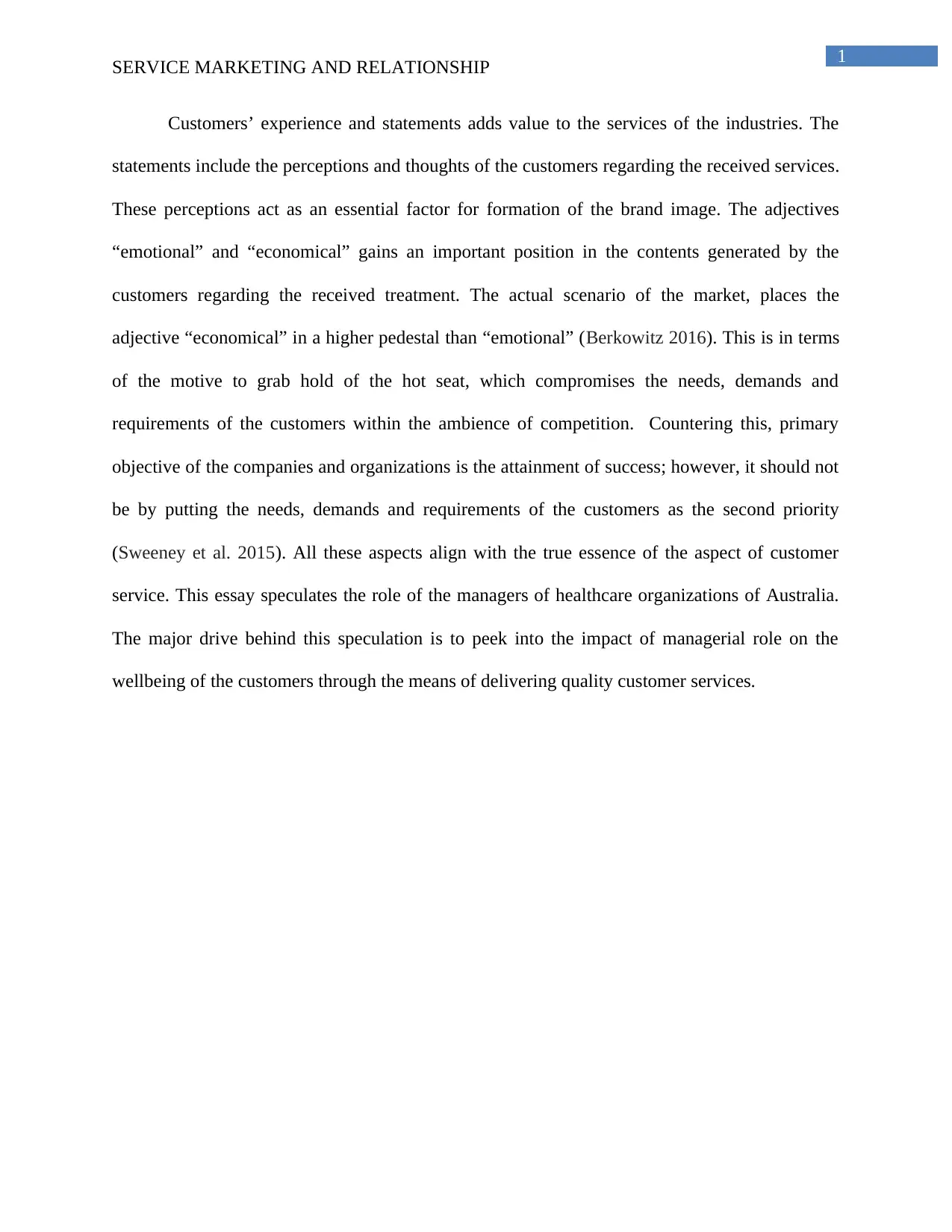
1
SERVICE MARKETING AND RELATIONSHIP
Customers’ experience and statements adds value to the services of the industries. The
statements include the perceptions and thoughts of the customers regarding the received services.
These perceptions act as an essential factor for formation of the brand image. The adjectives
“emotional” and “economical” gains an important position in the contents generated by the
customers regarding the received treatment. The actual scenario of the market, places the
adjective “economical” in a higher pedestal than “emotional” (Berkowitz 2016). This is in terms
of the motive to grab hold of the hot seat, which compromises the needs, demands and
requirements of the customers within the ambience of competition. Countering this, primary
objective of the companies and organizations is the attainment of success; however, it should not
be by putting the needs, demands and requirements of the customers as the second priority
(Sweeney et al. 2015). All these aspects align with the true essence of the aspect of customer
service. This essay speculates the role of the managers of healthcare organizations of Australia.
The major drive behind this speculation is to peek into the impact of managerial role on the
wellbeing of the customers through the means of delivering quality customer services.
SERVICE MARKETING AND RELATIONSHIP
Customers’ experience and statements adds value to the services of the industries. The
statements include the perceptions and thoughts of the customers regarding the received services.
These perceptions act as an essential factor for formation of the brand image. The adjectives
“emotional” and “economical” gains an important position in the contents generated by the
customers regarding the received treatment. The actual scenario of the market, places the
adjective “economical” in a higher pedestal than “emotional” (Berkowitz 2016). This is in terms
of the motive to grab hold of the hot seat, which compromises the needs, demands and
requirements of the customers within the ambience of competition. Countering this, primary
objective of the companies and organizations is the attainment of success; however, it should not
be by putting the needs, demands and requirements of the customers as the second priority
(Sweeney et al. 2015). All these aspects align with the true essence of the aspect of customer
service. This essay speculates the role of the managers of healthcare organizations of Australia.
The major drive behind this speculation is to peek into the impact of managerial role on the
wellbeing of the customers through the means of delivering quality customer services.
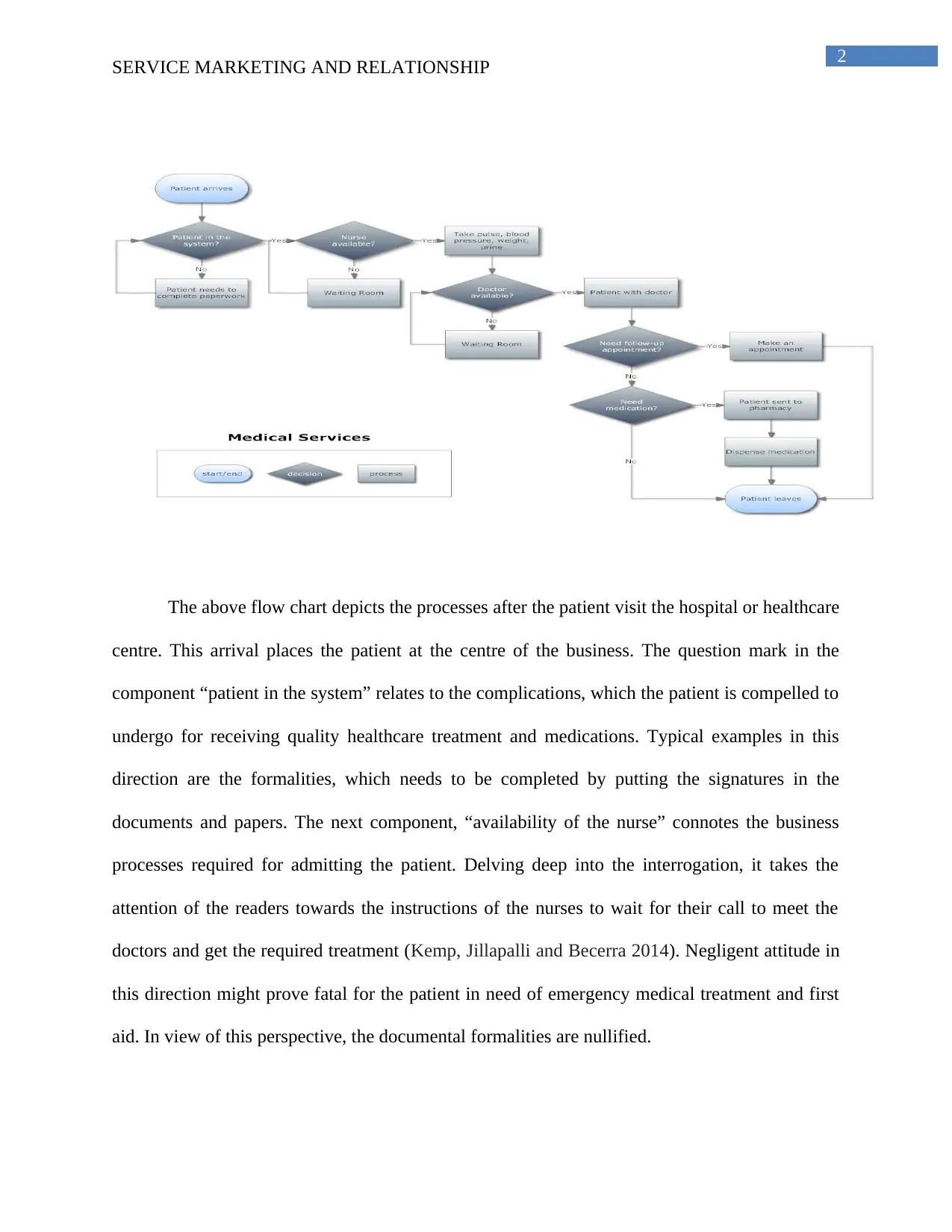
2
SERVICE MARKETING AND RELATIONSHIP
The above flow chart depicts the processes after the patient visit the hospital or healthcare
centre. This arrival places the patient at the centre of the business. The question mark in the
component “patient in the system” relates to the complications, which the patient is compelled to
undergo for receiving quality healthcare treatment and medications. Typical examples in this
direction are the formalities, which needs to be completed by putting the signatures in the
documents and papers. The next component, “availability of the nurse” connotes the business
processes required for admitting the patient. Delving deep into the interrogation, it takes the
attention of the readers towards the instructions of the nurses to wait for their call to meet the
doctors and get the required treatment (Kemp, Jillapalli and Becerra 2014). Negligent attitude in
this direction might prove fatal for the patient in need of emergency medical treatment and first
aid. In view of this perspective, the documental formalities are nullified.
SERVICE MARKETING AND RELATIONSHIP
The above flow chart depicts the processes after the patient visit the hospital or healthcare
centre. This arrival places the patient at the centre of the business. The question mark in the
component “patient in the system” relates to the complications, which the patient is compelled to
undergo for receiving quality healthcare treatment and medications. Typical examples in this
direction are the formalities, which needs to be completed by putting the signatures in the
documents and papers. The next component, “availability of the nurse” connotes the business
processes required for admitting the patient. Delving deep into the interrogation, it takes the
attention of the readers towards the instructions of the nurses to wait for their call to meet the
doctors and get the required treatment (Kemp, Jillapalli and Becerra 2014). Negligent attitude in
this direction might prove fatal for the patient in need of emergency medical treatment and first
aid. In view of this perspective, the documental formalities are nullified.
⊘ This is a preview!⊘
Do you want full access?
Subscribe today to unlock all pages.

Trusted by 1+ million students worldwide
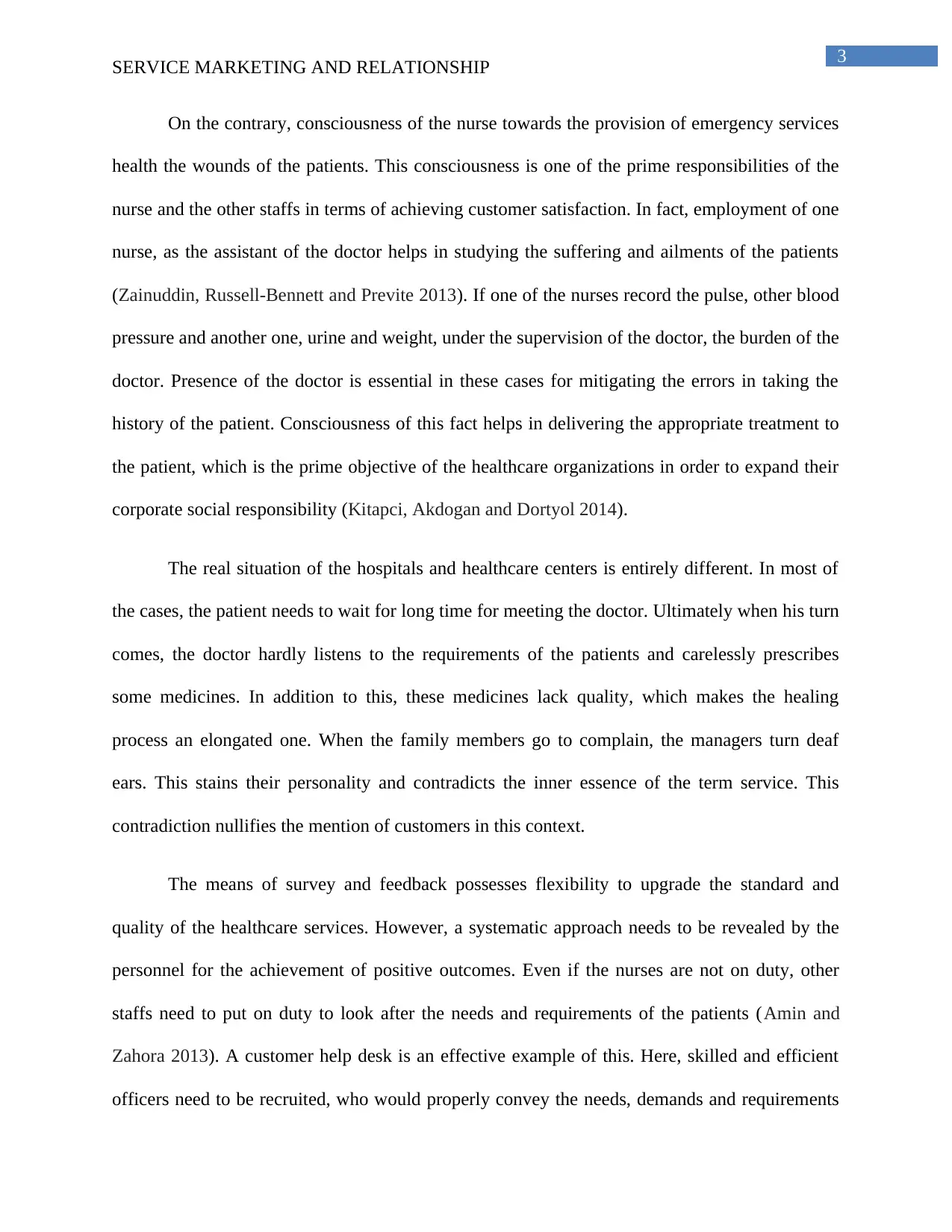
3
SERVICE MARKETING AND RELATIONSHIP
On the contrary, consciousness of the nurse towards the provision of emergency services
health the wounds of the patients. This consciousness is one of the prime responsibilities of the
nurse and the other staffs in terms of achieving customer satisfaction. In fact, employment of one
nurse, as the assistant of the doctor helps in studying the suffering and ailments of the patients
(Zainuddin, Russell-Bennett and Previte 2013). If one of the nurses record the pulse, other blood
pressure and another one, urine and weight, under the supervision of the doctor, the burden of the
doctor. Presence of the doctor is essential in these cases for mitigating the errors in taking the
history of the patient. Consciousness of this fact helps in delivering the appropriate treatment to
the patient, which is the prime objective of the healthcare organizations in order to expand their
corporate social responsibility (Kitapci, Akdogan and Dortyol 2014).
The real situation of the hospitals and healthcare centers is entirely different. In most of
the cases, the patient needs to wait for long time for meeting the doctor. Ultimately when his turn
comes, the doctor hardly listens to the requirements of the patients and carelessly prescribes
some medicines. In addition to this, these medicines lack quality, which makes the healing
process an elongated one. When the family members go to complain, the managers turn deaf
ears. This stains their personality and contradicts the inner essence of the term service. This
contradiction nullifies the mention of customers in this context.
The means of survey and feedback possesses flexibility to upgrade the standard and
quality of the healthcare services. However, a systematic approach needs to be revealed by the
personnel for the achievement of positive outcomes. Even if the nurses are not on duty, other
staffs need to put on duty to look after the needs and requirements of the patients (Amin and
Zahora 2013). A customer help desk is an effective example of this. Here, skilled and efficient
officers need to be recruited, who would properly convey the needs, demands and requirements
SERVICE MARKETING AND RELATIONSHIP
On the contrary, consciousness of the nurse towards the provision of emergency services
health the wounds of the patients. This consciousness is one of the prime responsibilities of the
nurse and the other staffs in terms of achieving customer satisfaction. In fact, employment of one
nurse, as the assistant of the doctor helps in studying the suffering and ailments of the patients
(Zainuddin, Russell-Bennett and Previte 2013). If one of the nurses record the pulse, other blood
pressure and another one, urine and weight, under the supervision of the doctor, the burden of the
doctor. Presence of the doctor is essential in these cases for mitigating the errors in taking the
history of the patient. Consciousness of this fact helps in delivering the appropriate treatment to
the patient, which is the prime objective of the healthcare organizations in order to expand their
corporate social responsibility (Kitapci, Akdogan and Dortyol 2014).
The real situation of the hospitals and healthcare centers is entirely different. In most of
the cases, the patient needs to wait for long time for meeting the doctor. Ultimately when his turn
comes, the doctor hardly listens to the requirements of the patients and carelessly prescribes
some medicines. In addition to this, these medicines lack quality, which makes the healing
process an elongated one. When the family members go to complain, the managers turn deaf
ears. This stains their personality and contradicts the inner essence of the term service. This
contradiction nullifies the mention of customers in this context.
The means of survey and feedback possesses flexibility to upgrade the standard and
quality of the healthcare services. However, a systematic approach needs to be revealed by the
personnel for the achievement of positive outcomes. Even if the nurses are not on duty, other
staffs need to put on duty to look after the needs and requirements of the patients (Amin and
Zahora 2013). A customer help desk is an effective example of this. Here, skilled and efficient
officers need to be recruited, who would properly convey the needs, demands and requirements
Paraphrase This Document
Need a fresh take? Get an instant paraphrase of this document with our AI Paraphraser
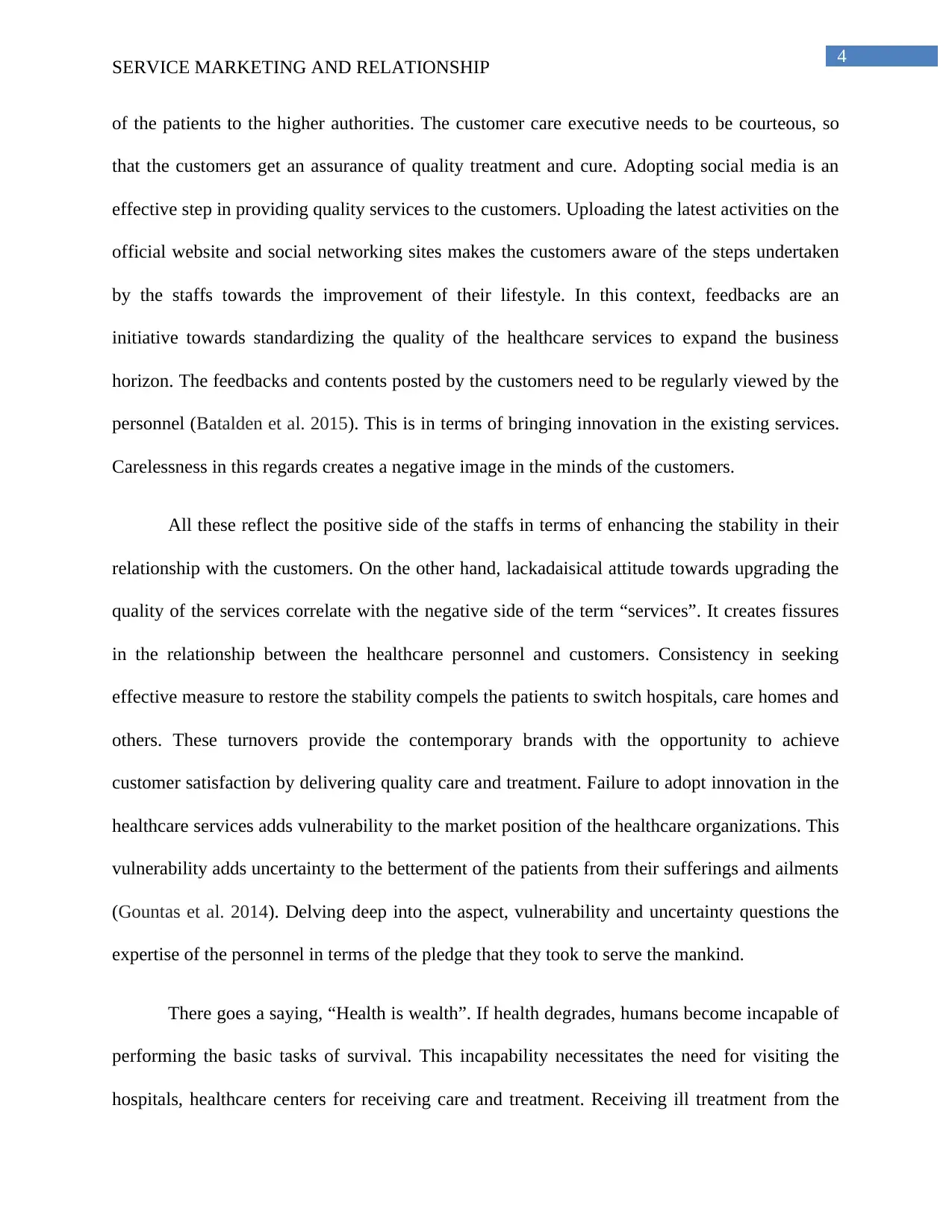
4
SERVICE MARKETING AND RELATIONSHIP
of the patients to the higher authorities. The customer care executive needs to be courteous, so
that the customers get an assurance of quality treatment and cure. Adopting social media is an
effective step in providing quality services to the customers. Uploading the latest activities on the
official website and social networking sites makes the customers aware of the steps undertaken
by the staffs towards the improvement of their lifestyle. In this context, feedbacks are an
initiative towards standardizing the quality of the healthcare services to expand the business
horizon. The feedbacks and contents posted by the customers need to be regularly viewed by the
personnel (Batalden et al. 2015). This is in terms of bringing innovation in the existing services.
Carelessness in this regards creates a negative image in the minds of the customers.
All these reflect the positive side of the staffs in terms of enhancing the stability in their
relationship with the customers. On the other hand, lackadaisical attitude towards upgrading the
quality of the services correlate with the negative side of the term “services”. It creates fissures
in the relationship between the healthcare personnel and customers. Consistency in seeking
effective measure to restore the stability compels the patients to switch hospitals, care homes and
others. These turnovers provide the contemporary brands with the opportunity to achieve
customer satisfaction by delivering quality care and treatment. Failure to adopt innovation in the
healthcare services adds vulnerability to the market position of the healthcare organizations. This
vulnerability adds uncertainty to the betterment of the patients from their sufferings and ailments
(Gountas et al. 2014). Delving deep into the aspect, vulnerability and uncertainty questions the
expertise of the personnel in terms of the pledge that they took to serve the mankind.
There goes a saying, “Health is wealth”. If health degrades, humans become incapable of
performing the basic tasks of survival. This incapability necessitates the need for visiting the
hospitals, healthcare centers for receiving care and treatment. Receiving ill treatment from the
SERVICE MARKETING AND RELATIONSHIP
of the patients to the higher authorities. The customer care executive needs to be courteous, so
that the customers get an assurance of quality treatment and cure. Adopting social media is an
effective step in providing quality services to the customers. Uploading the latest activities on the
official website and social networking sites makes the customers aware of the steps undertaken
by the staffs towards the improvement of their lifestyle. In this context, feedbacks are an
initiative towards standardizing the quality of the healthcare services to expand the business
horizon. The feedbacks and contents posted by the customers need to be regularly viewed by the
personnel (Batalden et al. 2015). This is in terms of bringing innovation in the existing services.
Carelessness in this regards creates a negative image in the minds of the customers.
All these reflect the positive side of the staffs in terms of enhancing the stability in their
relationship with the customers. On the other hand, lackadaisical attitude towards upgrading the
quality of the services correlate with the negative side of the term “services”. It creates fissures
in the relationship between the healthcare personnel and customers. Consistency in seeking
effective measure to restore the stability compels the patients to switch hospitals, care homes and
others. These turnovers provide the contemporary brands with the opportunity to achieve
customer satisfaction by delivering quality care and treatment. Failure to adopt innovation in the
healthcare services adds vulnerability to the market position of the healthcare organizations. This
vulnerability adds uncertainty to the betterment of the patients from their sufferings and ailments
(Gountas et al. 2014). Delving deep into the aspect, vulnerability and uncertainty questions the
expertise of the personnel in terms of the pledge that they took to serve the mankind.
There goes a saying, “Health is wealth”. If health degrades, humans become incapable of
performing the basic tasks of survival. This incapability necessitates the need for visiting the
hospitals, healthcare centers for receiving care and treatment. Receiving ill treatment from the
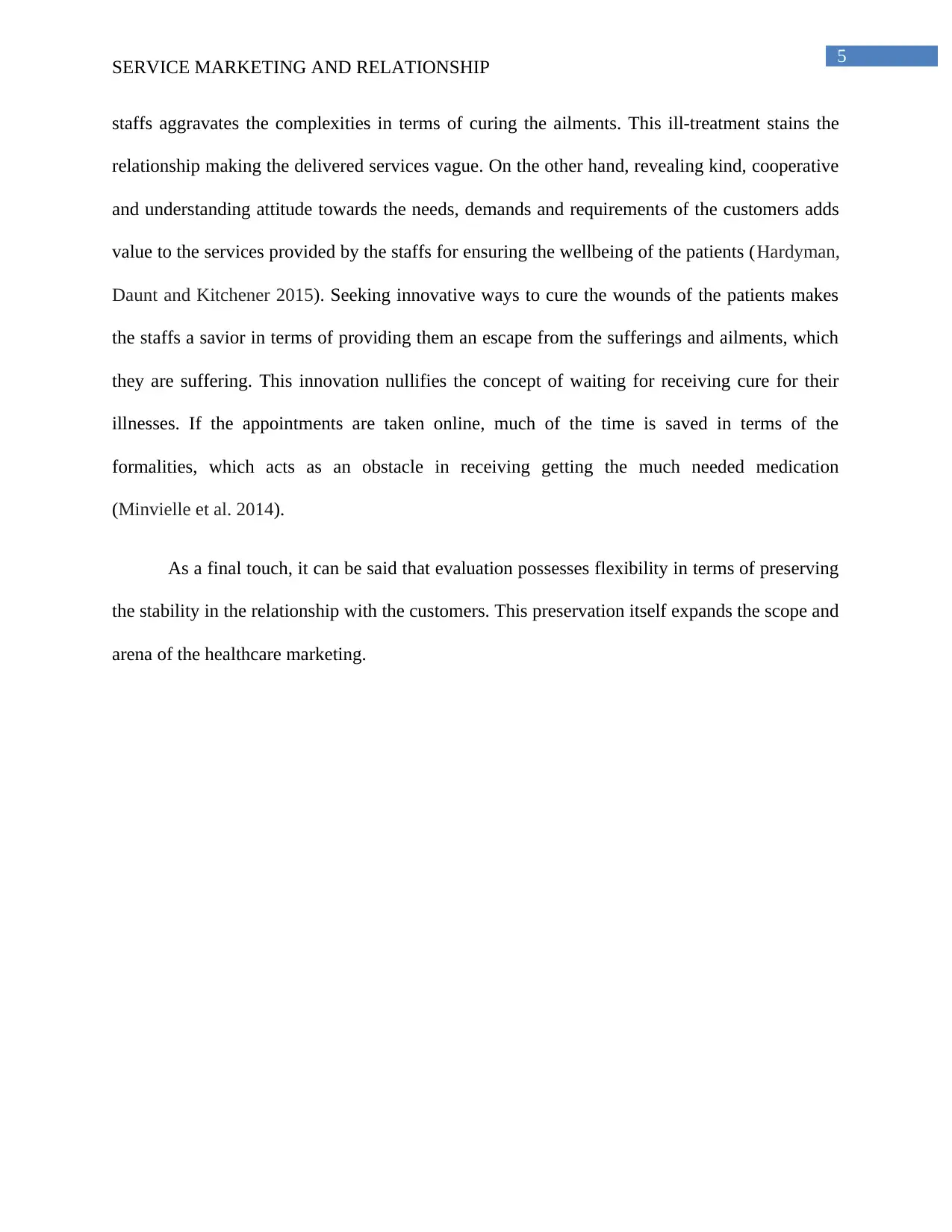
5
SERVICE MARKETING AND RELATIONSHIP
staffs aggravates the complexities in terms of curing the ailments. This ill-treatment stains the
relationship making the delivered services vague. On the other hand, revealing kind, cooperative
and understanding attitude towards the needs, demands and requirements of the customers adds
value to the services provided by the staffs for ensuring the wellbeing of the patients (Hardyman,
Daunt and Kitchener 2015). Seeking innovative ways to cure the wounds of the patients makes
the staffs a savior in terms of providing them an escape from the sufferings and ailments, which
they are suffering. This innovation nullifies the concept of waiting for receiving cure for their
illnesses. If the appointments are taken online, much of the time is saved in terms of the
formalities, which acts as an obstacle in receiving getting the much needed medication
(Minvielle et al. 2014).
As a final touch, it can be said that evaluation possesses flexibility in terms of preserving
the stability in the relationship with the customers. This preservation itself expands the scope and
arena of the healthcare marketing.
SERVICE MARKETING AND RELATIONSHIP
staffs aggravates the complexities in terms of curing the ailments. This ill-treatment stains the
relationship making the delivered services vague. On the other hand, revealing kind, cooperative
and understanding attitude towards the needs, demands and requirements of the customers adds
value to the services provided by the staffs for ensuring the wellbeing of the patients (Hardyman,
Daunt and Kitchener 2015). Seeking innovative ways to cure the wounds of the patients makes
the staffs a savior in terms of providing them an escape from the sufferings and ailments, which
they are suffering. This innovation nullifies the concept of waiting for receiving cure for their
illnesses. If the appointments are taken online, much of the time is saved in terms of the
formalities, which acts as an obstacle in receiving getting the much needed medication
(Minvielle et al. 2014).
As a final touch, it can be said that evaluation possesses flexibility in terms of preserving
the stability in the relationship with the customers. This preservation itself expands the scope and
arena of the healthcare marketing.
⊘ This is a preview!⊘
Do you want full access?
Subscribe today to unlock all pages.

Trusted by 1+ million students worldwide
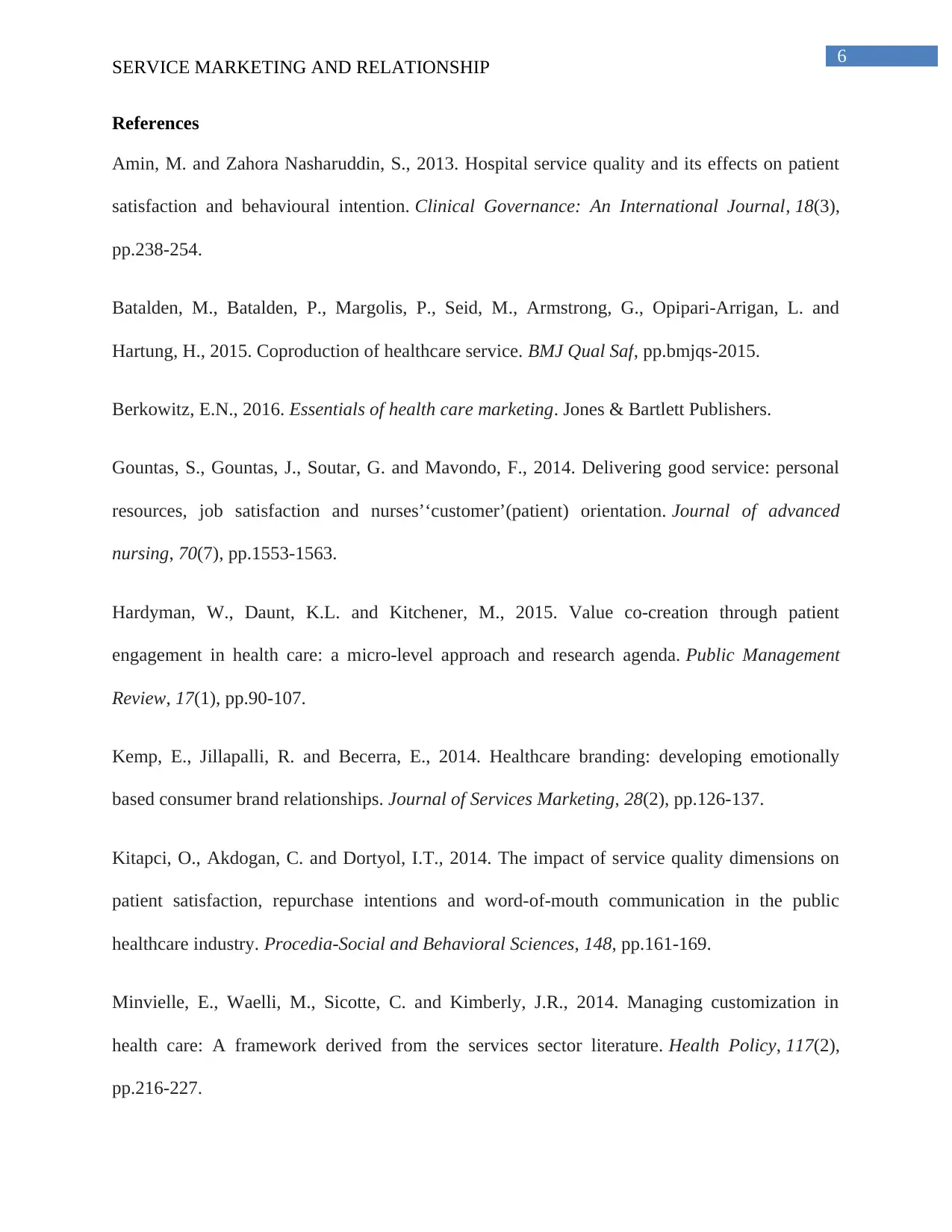
6
SERVICE MARKETING AND RELATIONSHIP
References
Amin, M. and Zahora Nasharuddin, S., 2013. Hospital service quality and its effects on patient
satisfaction and behavioural intention. Clinical Governance: An International Journal, 18(3),
pp.238-254.
Batalden, M., Batalden, P., Margolis, P., Seid, M., Armstrong, G., Opipari-Arrigan, L. and
Hartung, H., 2015. Coproduction of healthcare service. BMJ Qual Saf, pp.bmjqs-2015.
Berkowitz, E.N., 2016. Essentials of health care marketing. Jones & Bartlett Publishers.
Gountas, S., Gountas, J., Soutar, G. and Mavondo, F., 2014. Delivering good service: personal
resources, job satisfaction and nurses’‘customer’(patient) orientation. Journal of advanced
nursing, 70(7), pp.1553-1563.
Hardyman, W., Daunt, K.L. and Kitchener, M., 2015. Value co-creation through patient
engagement in health care: a micro-level approach and research agenda. Public Management
Review, 17(1), pp.90-107.
Kemp, E., Jillapalli, R. and Becerra, E., 2014. Healthcare branding: developing emotionally
based consumer brand relationships. Journal of Services Marketing, 28(2), pp.126-137.
Kitapci, O., Akdogan, C. and Dortyol, I.T., 2014. The impact of service quality dimensions on
patient satisfaction, repurchase intentions and word-of-mouth communication in the public
healthcare industry. Procedia-Social and Behavioral Sciences, 148, pp.161-169.
Minvielle, E., Waelli, M., Sicotte, C. and Kimberly, J.R., 2014. Managing customization in
health care: A framework derived from the services sector literature. Health Policy, 117(2),
pp.216-227.
SERVICE MARKETING AND RELATIONSHIP
References
Amin, M. and Zahora Nasharuddin, S., 2013. Hospital service quality and its effects on patient
satisfaction and behavioural intention. Clinical Governance: An International Journal, 18(3),
pp.238-254.
Batalden, M., Batalden, P., Margolis, P., Seid, M., Armstrong, G., Opipari-Arrigan, L. and
Hartung, H., 2015. Coproduction of healthcare service. BMJ Qual Saf, pp.bmjqs-2015.
Berkowitz, E.N., 2016. Essentials of health care marketing. Jones & Bartlett Publishers.
Gountas, S., Gountas, J., Soutar, G. and Mavondo, F., 2014. Delivering good service: personal
resources, job satisfaction and nurses’‘customer’(patient) orientation. Journal of advanced
nursing, 70(7), pp.1553-1563.
Hardyman, W., Daunt, K.L. and Kitchener, M., 2015. Value co-creation through patient
engagement in health care: a micro-level approach and research agenda. Public Management
Review, 17(1), pp.90-107.
Kemp, E., Jillapalli, R. and Becerra, E., 2014. Healthcare branding: developing emotionally
based consumer brand relationships. Journal of Services Marketing, 28(2), pp.126-137.
Kitapci, O., Akdogan, C. and Dortyol, I.T., 2014. The impact of service quality dimensions on
patient satisfaction, repurchase intentions and word-of-mouth communication in the public
healthcare industry. Procedia-Social and Behavioral Sciences, 148, pp.161-169.
Minvielle, E., Waelli, M., Sicotte, C. and Kimberly, J.R., 2014. Managing customization in
health care: A framework derived from the services sector literature. Health Policy, 117(2),
pp.216-227.
Paraphrase This Document
Need a fresh take? Get an instant paraphrase of this document with our AI Paraphraser
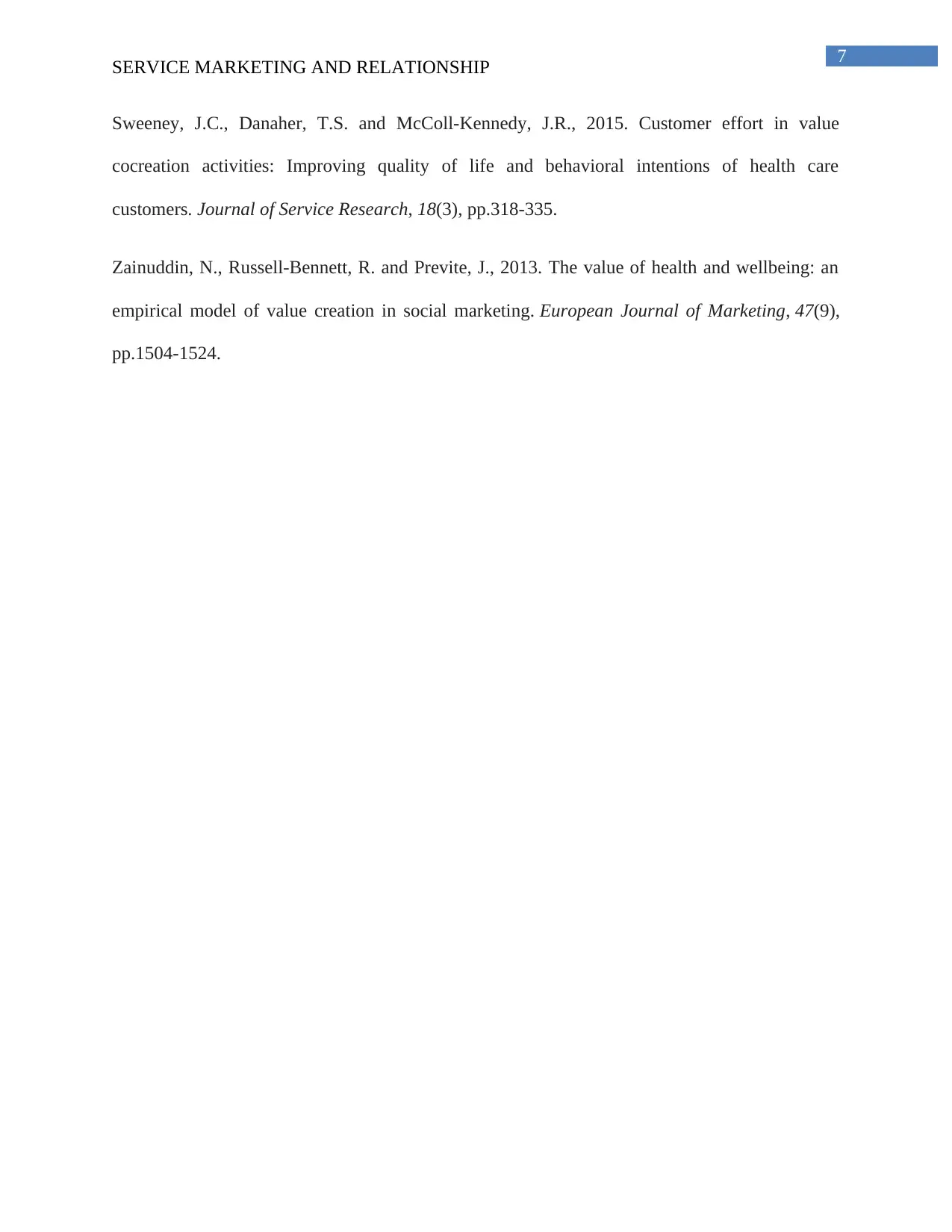
7
SERVICE MARKETING AND RELATIONSHIP
Sweeney, J.C., Danaher, T.S. and McColl-Kennedy, J.R., 2015. Customer effort in value
cocreation activities: Improving quality of life and behavioral intentions of health care
customers. Journal of Service Research, 18(3), pp.318-335.
Zainuddin, N., Russell-Bennett, R. and Previte, J., 2013. The value of health and wellbeing: an
empirical model of value creation in social marketing. European Journal of Marketing, 47(9),
pp.1504-1524.
SERVICE MARKETING AND RELATIONSHIP
Sweeney, J.C., Danaher, T.S. and McColl-Kennedy, J.R., 2015. Customer effort in value
cocreation activities: Improving quality of life and behavioral intentions of health care
customers. Journal of Service Research, 18(3), pp.318-335.
Zainuddin, N., Russell-Bennett, R. and Previte, J., 2013. The value of health and wellbeing: an
empirical model of value creation in social marketing. European Journal of Marketing, 47(9),
pp.1504-1524.
1 out of 8
Related Documents
Your All-in-One AI-Powered Toolkit for Academic Success.
+13062052269
info@desklib.com
Available 24*7 on WhatsApp / Email
![[object Object]](/_next/static/media/star-bottom.7253800d.svg)
Unlock your academic potential
Copyright © 2020–2025 A2Z Services. All Rights Reserved. Developed and managed by ZUCOL.





